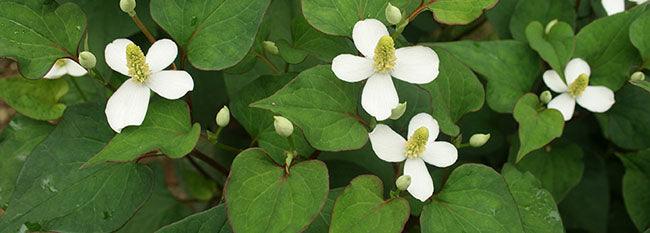QUICK FACTS
Scientific name: Houttuynia cordata
Other names: Chameleon plant, fish wort, heart leaf, Chinese lizard tail, yu xing cao (Chinese), plu-khao (Thai)
Location: Native to China, Japan, Korea, and Southeast Asia
Known for: Its use as a medicinal herb and food in many Asian countries
Part Used: Whole plant (especially the above-ground parts)
Fun fact: The genus name Houttuynia comes from the 18th-century Dutch naturalist Martin Houttuynia.1
Good for: Immune health, microbiome balance, optimal digestion, healthy inflammation levels, fighting infections, liver protection
Key Properties & Actions: Immunomodulator, antimicrobial, anti-inflammatory, antioxidant, anti-tumor, hepatoprotective, neuroprotective
What is Houttuynia?
Houttuynia is a creeping perennial plant native to multiple Southeastern Asian countries. Although it is primarily used as a food and herbal medicine, it is also a striking and colorful groundcover that adds visual interest to whatever landscape it is a part of.
Houttuynia’s heart-shaped leaves are marbled with a variation of green to white, yellow, pink, and red. Its species name, cordata, is a nod to these heart-shaped leaves.

Given the right conditions, houttuynia spreads quickly and can reach 6 to 20 inches in height. It thrives in wet soil and can be found growing along shaded hillsides, roadsides, and field ridges.
Although this plant is more well-known in Asian countries, it is gaining popularity in the West for its impressive immune-balancing, microbiome-balancing, and anti-inflammatory effects. Likewise, there is a growing number of modern scientific research studies being conducted on this exciting plant.
Benefits of Houttuynia and How It Works
Balanced Immune System
Houttuynia contains biologically active compounds that exert a balancing effect on the immune system. This means it can calm the excessive inflammation and immune response associated with conditions like allergies and autoimmunity, while stimulating the immune system in the presence of pathogens and infections.
A 2021 in vitro and in vivo study published in the scientific, peer-reviewed journal Food demonstrated houttuynia’s ability to stimulate the immune system. The study showed that a fermented houttuynia product was able to enhance immune cell activity and antibody production.2
Additionally, houttuynia can downregulate allergic responses and decrease the release of histamine.3
A 2005 animal study administered a houttuynia extract to mice, which helped to inhibit mast cell activity, histamine release, and anaphylaxis.4
Antimicrobial Benefits
Houttuynia has exhibited both antiviral and antibacterial activity in modern scientific research studies and is commonly used to fight viral infections in Asian countries.5,6,7
In traditional Chinese medicine, it is combined with forsythia and magnolia for pneumonia caused by viral infection. In 2003, during the severe acute respiratory syndrome (SARS) virus infection outbreak, the Health Ministry of China administered houttuynia.7
A 2021 in vitro study found that several bioactive compounds in houttuynia were able to fight SARS-CoV-2 (the virus responsible for COVID-19) by binding to an enzyme involved in the replication and transcription of the virus.8
Healthy Digestion and Gut Microbiome
Houttuynia has anti-inflammatory and antimicrobial effects that benefit the digestive system.
Houttuynia supports healthy intestinal flora and can reduce inflammation in the intestines. These actions help strengthen the intestinal barrier and support optimal digestion and absorption of nutrients.7,9
Interestingly, houttuynia’s beneficial effects on the gut microbiome may also have positive implications for blood sugar balance.
A 2017 study published in Genes, a peer-reviewed journal of genetics and genomics, observed the anti-diabetic effect of a houttuynia extract and metformin (a prescription diabetes medication) combination in vitro and in vivo.10
The study found that the combination was more effective than metformin alone in improving glucose metabolism and insulin sensitivity. The authors believe houttuynia’s ability to regulate the gut microbiome is the main mechanism of action.10
Anti-Inflammatory Activity
In vitro and in vivo studies show houttuynia has anti-inflammatory effects via mechanisms like reducing inflammatory markers and modulating inflammatory pathways.6
Houttuynia has been shown to exert its anti-inflammatory activity on various organs and systems of the body, including the digestive system, urinary tract, brain, and liver.6,7,9,11
A 2020 animal study showed that houttuynia extract can calm the excessive mast cell activity and inflammation seen in interstitial cystitis.12
Liver Protection
Houttuynia possesses antioxidant actions that can help protect the liver.
A 2012 animal study gave a houttuynia extract to mice experiencing acute liver toxicity. The results of the study indicated that houttuynia extract possesses a significant protective effect against acute liver toxicity, possibly due to its strong antioxidant capacity.7,13
History & Traditional Use
Houttuynia has a long history of use as a food and herbal medicine in many Asian countries.
It has been traditionally used as medicine for inflammation, arthritis, infections, sinusitis, allergies, and more.6
As a food, it is commonly prepared as a side dish and is enjoyed in countries such as China, Korea, Japan, and Thailand. In Northeastern India, it is considered a delicacy.
In Thailand, it is known as plu-khao, which means fishy-smelling vegetable due to its fishy aroma.7
In China, the above-ground parts of the plant are used for respiratory ailments including pneumonia. It is an important herb in traditional Chinese medicine, where it is used for inflammation, urinary tract health, a variety of infections, lowering fever, and more.
How to Use and Dosing
Houttuynia is described by some as being an acquired taste, so for medicinal purposes it is most commonly taken as a tincture.

The general dosage for a houttuynia tincture is 3-4 mL, 2-3 times daily.
For immunomodulatory support, houttuynia combines well with Chinese skullcap, Japanese knotweed, and reishi mushroom.
To enhance houttuynia’s antimicrobial effects, try combining it with andrographis, cat’s claw, prickly ash, and Chinese salvia.
Interactions
There are no known interactions
Always check with your health care practitioner before use if you are taking medications. For more general education on potential interactions between herbs and medications, check out Dr. Bill Rawls’ article: Is it Safe to Take Herbs with My Medications?
Precautions & Side effects
Check with your health care provider before using houttuynia if you are pregnant or breastfeeding. Houttuynia contains appreciable quantities of oxalates, so it should be avoided if following a low-oxalate diet.
Disclaimer: This information is intended only as general education and should not be substituted for professional medical advice. Any mentioned general dosage options, safety notices, or possible interactions with prescription drugs are for educational purposes only and must be considered in the context of each individual’s health situation and the quality and potency of the product being used. Use this information only as a reference in conjunction with the guidance of a qualified healthcare practitioner.
Want to See the Science? Check Out Our References Below.
1. Houttuynia cordata (Chameleon Plant, Rainbow Plant) | North Carolina Extension Gardener Plant Toolbox. plants.ces.ncsu.edu. Accessed January 8, 2023. https://plants.ces.ncsu.edu/plants/houttuynia-cordata/
2. Utaiwat S, Senawong G, Khongsukwiwat K, Woranam K, Sattayasai J, Senawong T. Immunomodulatory Potential of the Industrialized Houttuynia cordata Fermentation Product In Vitro and in Wistar Rats. Foods. 2021;10(11):2582. Published 2021 Oct 26. doi:10.3390/foods10112582
3. Shim SY, Seo YK, Park JR. Down-regulation of FcepsilonRI expression by Houttuynia cordata Thunb extract in human basophilic KU812F cells. J Med Food. 2009;12(2):383-388. doi:10.1089/jmf.2007.0684
4. Li GZ, Chai OH, Lee MS, Han EH, Kim HT, Song CH. Inhibitory effects of Houttuynia cordata water extracts on anaphylactic reaction and mast cell activation. Biol Pharm Bull. 2005;28(10):1864-1868. doi:10.1248/bpb.28.1864
5. Hung PY, Ho BC, Lee SY, et al. Houttuynia cordata targets the beginning stage of herpes simplex virus infection. PLoS One. 2015;10(2):e0115475. Published 2015 Feb 2. doi:10.1371/journal.pone.0115475
6. Laldinsangi C. The therapeutic potential of Houttuynia cordata: A current review. Heliyon. 2022;8(8):e10386. Published 2022 Aug 24. doi:10.1016/j.heliyon.2022.e10386
7. Wu Z, Deng X, Hu Q, et al. Houttuynia cordata Thunb: An Ethnopharmacological Review. Front Pharmacol. 2021;12:714694. Published 2021 Sep 1. doi:10.3389/fphar.2021.714694
8. Bahadur Gurung A, Ajmal Ali M, Lee J, Abul Farah M, Mashay Al-Anazi K, Al-Hemaid F. Identification of SARS-CoV-2 inhibitors from extracts of Houttuynia cordata Thunb. Saudi J Biol Sci. 2021;28(12):7517-7527. doi:10.1016/j.sjbs.2021.08.100
9. Chen MY, Li H, Lu XX, et al. Houttuynia cordata polysaccharide alleviated intestinal injury and modulated intestinal microbiota in H1N1 virus infected mice. Chin J Nat Med. 2019;17(3):187-197. doi:10.1016/S1875-5364(19)30021-4
10. Wang JH, Bose S, Lim SK, et al. Houttuynia cordata Facilitates Metformin on Ameliorating Insulin Resistance Associated with Gut Microbiota Alteration in OLETF Rats. Genes (Basel). 2017;8(10):239. Published 2017 Sep 22. doi:10.3390/genes8100239
11. Fang H, Yang Z, Yang L. Protective effect of Houttuynia cordata extract on propofol-induced injury of rat hippocampal neurons by regulating PI3K/Akt and Toll-like receptor 4/NF-κB signaling pathway. Neuroreport. 2021;32(7):577-582. doi:10.1097/WNR.0000000000001627
12. Li W, Yang F, Zhan H, et al. Houttuynia cordata Extract Ameliorates Bladder Damage and Improves Bladder Symptoms via Anti-Inflammatory Effect in Rats with Interstitial Cystitis. Evid Based Complement Alternat Med. 2020;2020:9026901. Published 2020 Oct 9. doi:10.1155/2020/9026901
13. Tian L, Shi X, Yu L, Zhu J, Ma R, Yang X. Chemical composition and hepatoprotective effects of polyphenol-rich extract from Houttuynia cordata tea. J Agric Food Chem. 2012;60(18):4641-4648. doi:10.1021/jf3008376
14. Shingnaisui K, Dey T, Manna P, Kalita J. Therapeutic potentials of Houttuynia cordata Thunb. against inflammation and oxidative stress: A review. J Ethnopharmacol. 2018;220:35-43. doi:10.1016/j.jep.2018.03.038
15. Kumar M, Prasad SK, Hemalatha S. A current update on the phytopharmacological aspects of Houttuynia cordata Thunb. Pharmacogn Rev. 2014;8(15):22-35. doi:10.4103/0973-7847.125525





